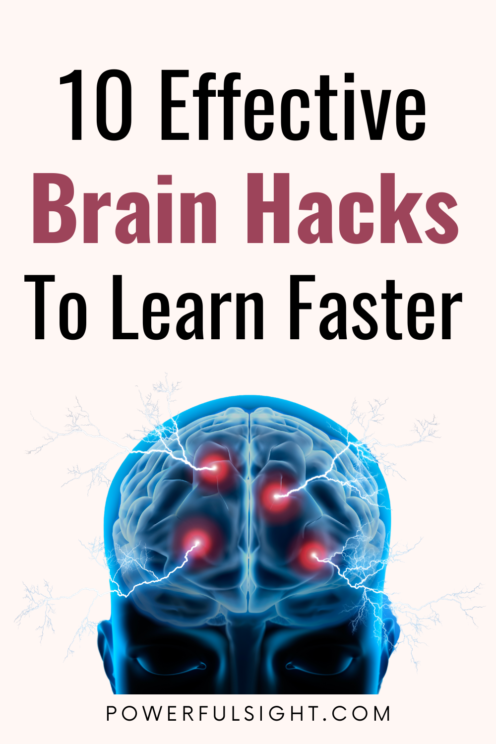Learning is an indispensable tool. But have you ever felt like despite putting in the hours, the information just doesn’t stick? Or perhaps you’ve experienced the frustration of forgetting something you thought you had mastered. If so, you’re certainly not alone, and the good news is that there are ways to turbocharge the learning process. These are not just any methods; they are brain hacks to learn faster, rooted in cognitive psychology and neuroscience.
Below are brain hacks to help you learn things faster.
Brain hacks to learn fast
1. Spaced Repetition
The first brain hack to learn faster is spaced repetition. You’ve likely experienced the all-night cram session before a big exam or presentation, only to find that much of what you “learned” has evaporated just days later. That’s because cramming is the antithesis of spaced repetition, a technique that could revolutionize your study habits.
Spaced repetition leverages the forgetting curve, a hypothesis that suggests we forget information over time if we don’t actively review it. By spacing out your study sessions, you allow your brain to partially forget and then re-learn the material, which strengthens your memory of it. Begin by reviewing new information within a day, then extend the intervals between reviews as you become more familiar with the material.
Implementing spaced repetition can be as simple as using a calendar to schedule review sessions or as sophisticated as employing software like Anki or Quizlet, which uses algorithms to determine the optimal intervals for review based on your performance. The key is consistency and allowing enough time between sessions for the information to begin to fade, thus making the recall process more effortful and the memory more durable.
Save the pin for later

2. Active Recall:
Instead of simply rereading material, actively engage with it by recalling information from memory.
Active recall is the deliberate act of trying to remember information without looking at the source. This is far more effective than passive review techniques such as rereading or highlighting, which can create the illusion of knowledge without actually enhancing memory.
One of the simplest ways to practice active recall is by using flashcards. Write down a question on one side and the answer on the other, then test yourself. Each time you successfully recall the information, it reinforces the neural pathways associated with that knowledge. Software like Anki can assist in this process by automating the spaced repetition component.
Another approach is to summarize what you’ve learned in your own words or to teach it to someone else. By forcing yourself to recall and articulate the material without prompts, you deepen your understanding and retention. Additionally, trying to anticipate test questions and answering them is an excellent method to employ active recall in a targeted manner.
Related: How to study effectively
3. Chunking:
Break down large pieces of information into smaller, manageable chunks.
When faced with a mountain of information, it’s easy to feel overwhelmed. That’s where chunking comes into play. It’s the process of breaking down complex information into smaller, more digestible pieces, which are easier to understand and remember.
To effectively chunk information, start by identifying the main concepts or steps in the material. Once you have these “big picture” chunks, break them down into smaller sub-concepts. This not only makes the information more manageable but also helps you to see how the pieces fit together within the larger framework.
For instance, if you’re learning a language, rather than trying to memorize a random list of vocabulary words, you could chunk the vocabulary by categories like food, travel, or family. In a subject like history, you could chunk by time periods or significant events. The key is to find meaningful groupings that make sense to you and align with the structure of the material you’re learning.
Related: How to prepare for exams
4. Visualization:
Create mental images or diagrams to represent complex concepts.
Visualization is a potent tool that can turn abstract concepts into concrete images, making them easier to comprehend and recall. When you create a mental image or diagram, you’re engaging different parts of your brain, which can help to solidify your memory of the material.
One effective technique is to use mind maps, which are visual representations of information that show relationships between different concepts. These can be particularly helpful for visual learners and can be used for note-taking, brainstorming, or reviewing material.
Another approach is to mentally associate complex information with a vivid image. For example, if you’re trying to remember a formula, you might visualize it as part of a story or as an image that symbolizes its components. The more unusual or emotionally charged the image, the more likely you are to remember it.
Related: How to take notes in school
Save the pin for later

5. Teach What You Learn:
Teaching others reinforces your own understanding of the material.
One of the most effective ways to ensure you’ve truly grasped a concept is to teach it to someone else. When you explain a concept to another person, you’re forced to articulate your thoughts clearly and check for gaps in your own understanding.
If there’s no one around to teach, pretend you’re teaching an imaginary audience or write a blog post about the topic. Alternatively, online forums and social media groups are great places to share your knowledge and engage with others who are learning the same material.
Remember, teaching doesn’t necessarily mean you need to be an expert. It’s about sharing what you know and learning through the process of communication. The act of preparing to teach can also deepen your understanding as you anticipate questions and think through the material from different angles.
Related: How to become an A Student
6. Interleaved Practice:
Mix up different topics or skills during your study sessions.
Interleaving is the practice of studying different subjects or topics in a single session, rather than focusing on one topic for an extended period. This approach encourages your brain to constantly switch gears and make connections between different pieces of information.
For example, if you’re learning to play a musical instrument, instead of practicing the same scale over and over, you might practice a variety of scales, chords, and pieces of music within the same practice session. Similarly, when studying mathematics, you might work on a set of problems that require different techniques rather than doing many repetitions of the same type of problem.
Interleaved practice can be challenging at first, as it feels more difficult than sticking to one topic or type of problem. However, this difficulty is a sign that deeper learning is taking place because your brain is being forced to differentiate between concepts and apply the right strategies to each new problem.
Related: How to improve your life
7. Utilize Mnemonics:
Mnemonic devices, such as acronyms or visual associations, can help you remember information more effectively.
Mnemonic devices are memory aids that help you encode and recall information more easily. They work by creating a bridge between new information and what you already know, often using humor or novelty to make the information more memorable.
Acronyms are one common type of mnemonic, where you take the first letter of each word or concept you need to remember and create a new word or phrase. For instance, the acronym “HOMES” can help you remember the names of the Great Lakes: Huron, Ontario, Michigan, Erie, and Superior.
Another type of mnemonic is the method of loci, also known as the memory palace technique. This involves visualizing a familiar place and “placing” the items you need to remember along a path through that location. As you mentally walk through your memory palace, you “see” the items in order and recall them.
Rhymes, songs, and peg systems (where you associate numbers with items) are other mnemonic devices that can aid in memorization. Experiment with different types to find what works best for you.
Related; How to memorize things faster
8. Take Breaks:
Give your brain time to rest and consolidate information by taking regular breaks during study sessions.
The importance of taking breaks cannot be overstressed. When you work for long periods without rest, your brain’s ability to retain information diminishes. Breaks can help prevent burnout and maintain high levels of performance.
The Pomodoro Technique is a popular method that involves working for 25 minutes and then taking a five-minute break. After four cycles, you take a longer break of about 15 to 30 minutes. This technique helps to maintain focus and gives your brain regular opportunities to rest and consolidate what you’ve learned.
During your breaks, it’s essential to truly step away from your work. Engage in activities that are different from what you’re studying, such as going for a walk, doing a quick workout, or simply relaxing. These activities can help to clear your mind and reduce stress, making it easier to return to your studies with fresh eyes.
Related: Good study habits to start
9. Multi-Sensory Learning:
Engage multiple senses during learning, such as listening to lectures, writing notes by hand, or using interactive learning tools.
Multi-sensory learning involves using more than one sense to learn and retain information. This method can improve memory encoding and retrieval by creating multiple associations in the brain.
For example, if you’re attending a lecture, don’t just listen; take notes by hand. The physical act of writing can help you remember the material better than typing because it involves more complex motor skills. If possible, discuss the material with classmates to engage your auditory and verbal processing.
Interactive learning tools, such as educational software and virtual labs, can also provide multi-sensory learning experiences. They often combine visual, auditory, and kinesthetic elements, offering a more immersive and engaging way to learn.
Remember, the goal is to engage as many senses as possible, so don’t be afraid to get creative. For instance, if you’re learning a new language, practice speaking out loud, listen to native speakers, write down new words, and use flashcards with images.
Related: How to study after a long break
10. Set Clear Goals:
Define specific, achievable learning goals to focus your efforts on and track your progress.
Setting clear, specific, and achievable goals can give direction to your learning efforts and help you stay motivated. Without goals, it’s easy to lose focus and get sidetracked by less important tasks.
Start by establishing what you want to achieve and by when. Make sure your goals are measurable, so you can track your progress. For example, instead of setting a goal to “learn Spanish,” set a goal to “complete a beginner’s Spanish course and have a five-minute conversation in Spanish within three months.”
Breaking down larger goals into smaller, more manageable ones can keep you motivated and provide a sense of accomplishment along the way. Celebrate these small victories to maintain momentum.
Related: How to set goals and achieve them
Final thoughts
In your journey to become a more effective learner, these ten brain hacks to learn faster are invaluable tools. Each of these techniques has the power to transform your learning experience and enable you to reach your full potential with less effort and in less time.
Save the pin for later
